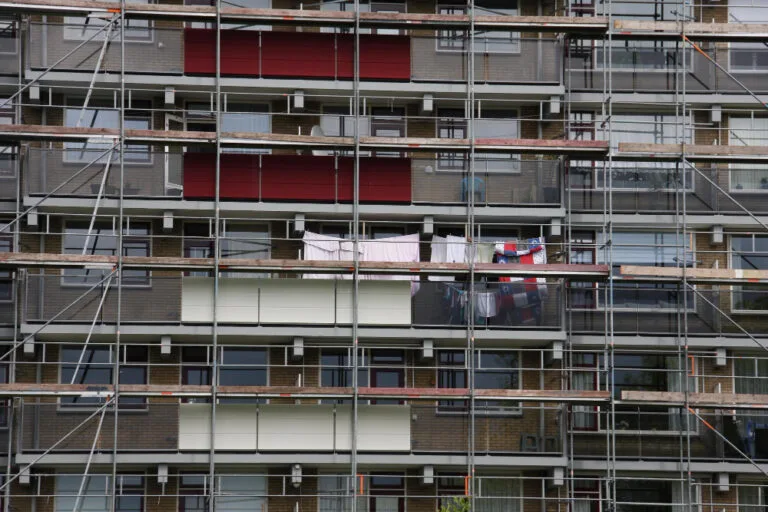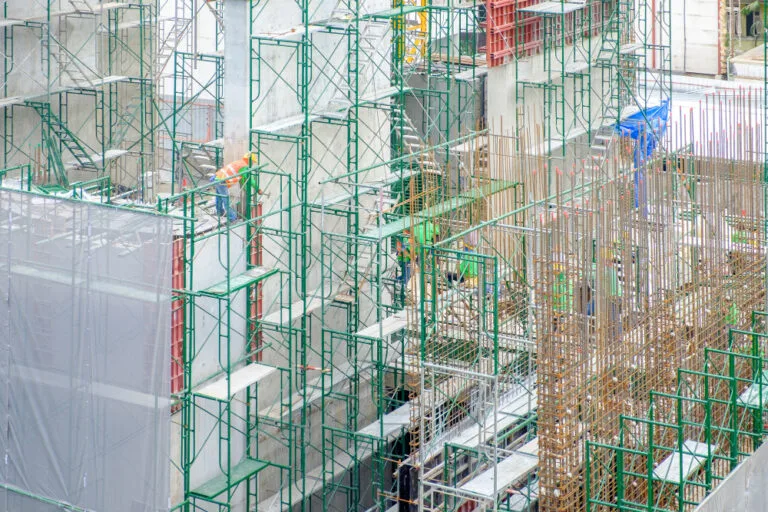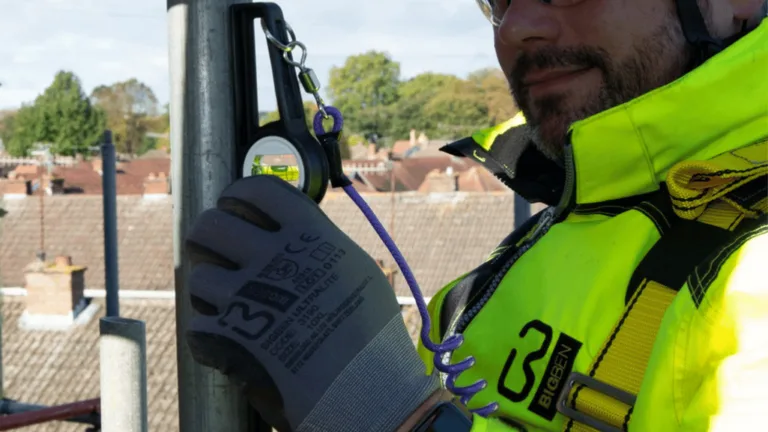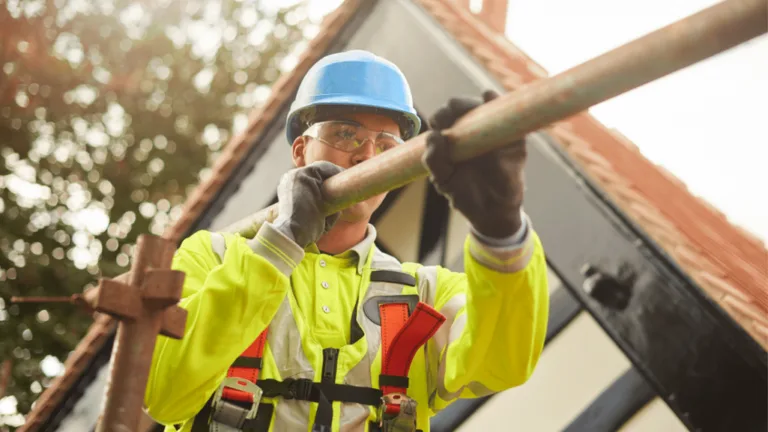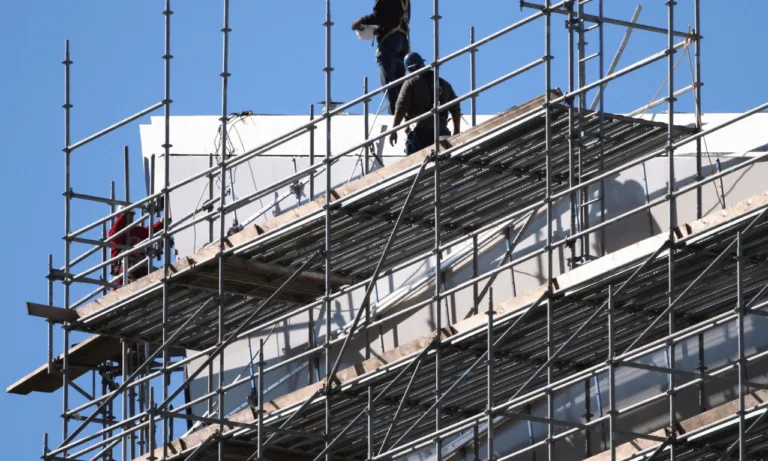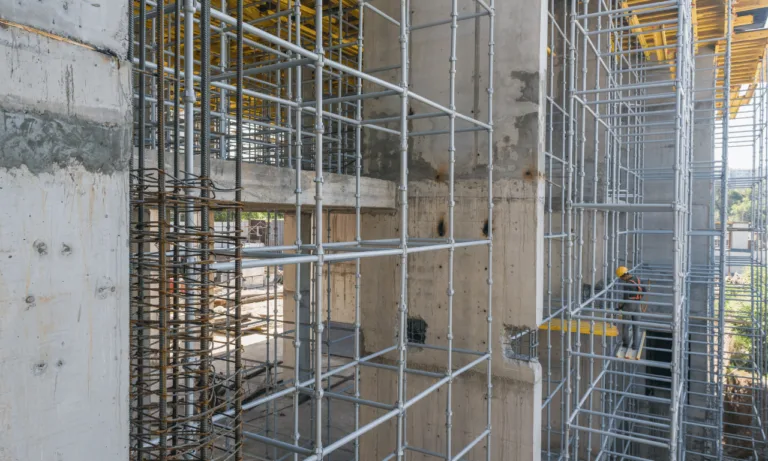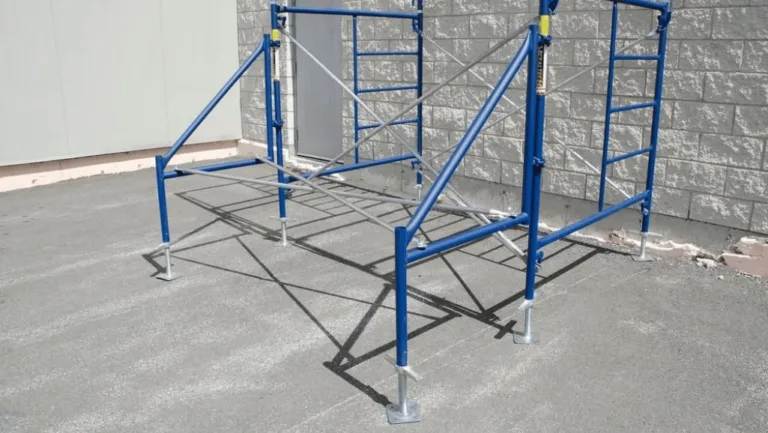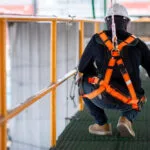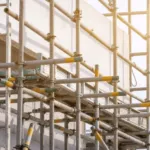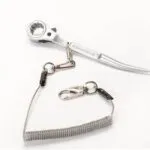Phone:
(+65)8319-0742
Construction sites can be hazardous environments, with workers often exposed to the risks of falls and falling debris. To ensure the safety of your workforce and meet regulatory standards, it is crucial to invest in high-quality Scaffold Safety Nets. These nets provide a reliable and effective solution for protecting workers from falls and preventing debris from causing potential harm or hazards.
OSHA compliant Scaffold Safety Nets are designed to meet the strict safety requirements set by the Occupational Safety and Health Administration (OSHA). By using these nets, construction sites can ensure compliance with OSHA standards and create a safer work environment for all workers involved in elevated projects.
Construction safety netting is specifically engineered to withstand the demanding conditions of construction sites. Made from durable and high-strength materials, these nets offer reliable protection against falls from heights. They are designed to catch falling objects, preventing them from reaching the ground or injuring workers below.
With their versatile applications, Scaffold Safety Nets can be installed around scaffolding, elevated work platforms, and high-rise structures. They provide a protective barrier that significantly reduces the risk of falls and helps maintain a safe and secure worksite.
Key Takeaways:
- Investing in Scaffold Safety Nets is crucial for ensuring workplace safety on construction sites.
- OSHA compliant Scaffold Safety Nets help construction sites meet regulatory standards and create a safer work environment.
- Construction safety netting is designed to withstand the demanding conditions of construction sites and provides reliable fall protection.
- Scaffold Safety Nets can be installed around scaffolding, elevated work platforms, and high-rise structures for enhanced worker safety.
- Using Scaffold Safety Nets helps prevent falls and protects workers from falling debris, reducing the risk of injuries and accidents.
Why Scaffold Safety Nets are Essential for Fall Protection
When it comes to ensuring the safety of workers on elevated work platforms, fall protection systems are crucial. Among these systems, Scaffold Safety Nets are an essential component that plays a significant role in preventing falls and enhancing elevated work safety.
These specialized nets are designed to provide a protective barrier that catches and securely contains workers in the event of a fall. Acting as a safety net, they minimize the risk of severe injuries, including fractures and fatalities.
Scaffold Safety Nets come in various types, each tailored to meet specific safety requirements. Some common types include:
- Safety Netting: This type of netting is installed horizontally, creating a reliable fall restraint system. It offers workers stability and prevents them from plunging to lower levels.
- Debris Netting: In addition to fall protection, debris netting reduces the risk of objects, tools, or construction materials falling from elevated work platforms. It effectively safeguards workers below and helps maintain a clean and hazard-free work environment.
By using Scaffold Safety Nets, workers can confidently carry out their tasks, knowing that they are protected from fall-related accidents. These nets act as a safety backup, providing peace of mind for workers and their employers.
Choosing Scaffold Safety Nets as part of your fall protection system offers several advantages:
- Enhanced Safety: With Scaffold Safety Nets in place, the risk of falls and injuries is greatly reduced, creating a safer working environment for everyone involved.
- Compliance with Regulations: Scaffold Safety Nets help construction sites meet regulatory standards, such as those set by OSHA, ensuring compliance and avoiding potential fines or penalties.
- Cost-Effective Solution: When compared to alternative fall protection systems, Scaffold Safety Nets are a cost-effective choice. They provide reliable protection without the need for complex installations or ongoing maintenance.
- Easy Installation and Maintenance: Scaffold Safety Nets are designed for convenient installation and maintenance. They can be easily secured to scaffolding systems and require minimal upkeep to remain effective.
Investing in Scaffold Safety Nets is a wise decision that reinforces your commitment to worker safety. By providing a reliable fall protection system, these nets are an essential component in safeguarding workers and preventing accidents.
Advantages of using Scaffold Safety Nets:
| Advantages | Description |
|---|---|
| 1. Enhanced Safety | Scaffold Safety Nets provide a reliable safety backup, minimizing the risk of falls and injuries. |
| 2. Regulatory Compliance | Using Scaffold Safety Nets ensures compliance with industry regulations, such as those set by OSHA. |
| 3. Cost-Effective | Compared to other fall protection systems, Scaffold Safety Nets offer a cost-effective solution without compromising safety. |
| 4. Ease of Installation and Maintenance | Scaffold Safety Nets are easy to install and require minimal maintenance, ensuring optimal functionality. |
Ensuring Compliance with OSHA Standards
Compliance with Occupational Safety and Health Administration (OSHA) standards is essential for maintaining a safe and secure construction site. When it comes to Scaffold Safety Nets, adhering to OSHA regulations is crucial to protect workers from potential accidents and falls. OSHA has specific requirements in place to ensure the effectiveness and reliability of construction safety netting.
Using OSHA compliant netting is not only a legal obligation but also a practical choice to enhance construction safety. OSHA compliant netting is designed and manufactured to meet the rigorous standards set by OSHA, ensuring its ability to withstand heavy loads and prevent falls. By using construction safety netting that meets OSHA standards, construction sites can ensure the safety and well-being of their workers.
The Importance of OSHA Compliant Netting
OSHA compliant netting offers a range of benefits that contribute to an elevated level of work safety. Here are some key advantages:
- Enhanced Protection: OSHA compliant netting provides superior protection against falls and potential injuries. With its high strength and durability, it can effectively catch and halt falling objects, safeguarding workers and the surrounding environment.
- Reliable Performance: OSHA compliant netting is rigorously tested and certified to meet specific safety standards. This ensures that the netting performs consistently and reliably, offering reliable fall protection and debris containment.
- Compliance with Regulations: By using OSHA compliant netting, construction sites can demonstrate their commitment to complying with OSHA regulations. This not only mitigates the risk of fines and penalties but also establishes a culture of safety and accountability in the workplace.
- Peace of Mind: OSHA compliant netting provides peace of mind to project managers, site supervisors, and workers alike. Knowing that they are using netting that meets OSHA standards instills confidence in the safety measures implemented on the construction site.
Investing in OSHA compliant netting is an investment in the safety and well-being of your workers. By ensuring compliance with OSHA standards, construction sites can create a secure environment that prioritizes worker safety and minimizes the risk of accidents and injuries.
OSHA Requirements for Construction Safety Netting
OSHA has established specific requirements for construction safety netting to ensure its effectiveness in fall protection and debris containment. Some of the key OSHA requirements for Scaffold Safety Nets include:
| OSHA Requirements | Explanation |
|---|---|
| Mesh Size | The netting must have a mesh size that prevents passage of objects that could cause injury or fall hazards. |
| Strength | The netting must be able to withstand the impact of falling objects and the force exerted by a falling worker. |
| Installation | The netting should be correctly installed and securely attached to prevent dislodging or collapsing when subjected to impact or loads. |
| Labeling | The netting should be labeled as meeting the requirements of OSHA standards. |
Meeting these requirements ensures that the Scaffold Safety Nets effectively protect workers from falls and debris, minimizing the risk of accidents and injuries on construction sites.
Debris Containment Solutions with Scaffold Safety Nets

One of the additional benefits of using Scaffold Safety Nets is their effectiveness in debris containment. These nets act as a barrier, preventing debris from falling off scaffolds and potentially causing harm or hazards to workers and the surrounding environment.
Debris containment nets are specifically designed to capture and secure loose materials such as tools, equipment, and construction debris. This not only improves site safety but also helps maintain cleanliness and order on construction sites.
When working on high-rise projects, where the risk of falling debris is even greater, deploying scaffold safety nets becomes even more critical. These high-rise safety solutions ensure that objects are contained within the work area, minimizing the risk of accidents or damage to property in the vicinity.
With debris containment nets in place, construction teams can focus on their tasks without the constant worry of materials falling from heights. This enhances productivity, reduces downtime, and promotes a safer work environment for all.
Benefits of Debris Containment Nets:
- Prevents debris from falling off scaffolds
- Reduces the risk of injuries caused by falling objects
- Maintains a clean and organized construction site
- Minimizes the potential for property damage
- Enhances overall work safety and productivity
By implementing debris containment nets as part of the scaffolding system, construction companies can proactively address safety concerns, comply with industry regulations, and protect both workers and the surrounding environment from potential hazards.
Features and Specifications of Scaffold Safety Nets

When it comes to construction safety netting, Scaffold Safety Nets are a vital component in ensuring a secure work environment for workers. These nets not only provide fall protection but also offer additional features that enhance their performance and usability on construction sites.
Key Features of Scaffold Safety Nets
- Durability: Scaffold Safety Nets are made from high-quality materials that are designed to withstand the rigors of construction work. They are built to be strong and durable, offering long-lasting protection.
- Customizability: These nets can be tailored to suit specific project requirements. Whether it’s a small-scale construction site or a high-rise project, Scaffold Safety Nets can be customized to fit any dimension or shape.
- Visibility: Scaffold Safety Nets are designed with high visibility in mind. Their vibrant colors ensure that workers can easily identify the netting, promoting awareness and reducing the risk of accidents.
- Easy Installation: These nets are easy to install, allowing for quick setup and dismantling. This saves time and ensures that work can proceed efficiently.
- Debris Containment: Scaffold Safety Nets not only provide fall protection but also act as debris containment solutions. Their tightly woven mesh prevents debris from falling off scaffolds, minimizing the potential hazards to workers and the surrounding environment.
Specifications of Scaffold Safety Nets
When selecting Scaffold Safety Nets for your construction project, it’s important to consider the specific specifications that meet your needs. Some common specifications to keep in mind include:
| Specification | Description |
|---|---|
| Mesh Size | The size of the individual openings in the netting. It determines the debris containment capabilities. |
| Breaking Strength | The maximum force the netting can withstand without breaking. It indicates the net’s overall strength and load-bearing capacity. |
| Fire Retardancy | Some Scaffold Safety Nets are treated with fire retardant materials, providing an extra layer of protection against fire hazards. |
| UV Stability | The ability of the netting to withstand prolonged exposure to ultraviolet (UV) rays without deteriorating or losing its strength. |
| Size and Shape | Scaffold Safety Nets are available in various sizes and shapes to accommodate different construction site configurations and requirements. |
By considering these features and specifications, you can ensure that you select the most suitable Scaffold Safety Nets for your construction project, providing enhanced safety for your workers and peace of mind for yourself.
Installation and Maintenance of Scaffold Safety Nets

Proper installation and regular maintenance are essential for ensuring the effectiveness and longevity of Scaffold Safety Nets. By following the correct procedures and implementing best practices, you can optimize the functionality and reliability of these crucial safety systems.
Installation
- Choose the right net: Before installation, make sure you have the appropriate Scaffold Safety Nets for your specific project requirements. Consider factors such as netting material, size, and load-bearing capacity.
- Inspect the scaffolding: Before installing the nets, inspect the scaffolding structure to ensure it is stable, properly assembled, and capable of supporting the weight of the nets.
- Secure the netting: Attach the netting securely to the scaffolding structure using suitable fasteners and connectors. Ensure that the nets cover all potential fall areas and provide complete protection.
- Regularly check for gaps: Regularly inspect the nets for any gaps, holes, or loose connections. Immediately repair or replace any damaged sections to maintain the integrity of the safety system.
Maintenance
Regular maintenance is crucial for keeping Scaffold Safety Nets in optimal condition:
- Inspect the nets: Conduct routine inspections to check for any signs of wear, tear, or damage. Look for frayed edges, holes, or weakened sections that may compromise the net’s effectiveness.
- Remove debris: Regularly remove any debris or objects that may accumulate on the nets. This helps prevent excess weight and ensures proper airflow through the netting.
- Clean the nets: Clean the nets periodically to remove dirt, dust, or other contaminants that may accumulate. Follow manufacturer guidelines for cleaning solutions and methods.
- Repair or replace: Promptly repair or replace any damaged or worn-out sections of the nets. Maintain a stock of spare parts to facilitate quick replacements and minimize downtime.
By following these installation and maintenance guidelines, you can ensure the Scaffold Safety Nets on your construction site are adequately installed, regularly maintained, and provide reliable fall protection for your workers.
Choosing the Right Scaffold Safety Net for Your Project
When it comes to ensuring the safety of construction sites, Scaffold Safety Nets play a crucial role. Selecting the right netting solution for your project is essential for protecting workers and complying with industry regulations. In this section, we will explore the factors to consider when choosing Scaffold Safety Nets, including project requirements, netting specifications, and specialized solutions for high-rise settings.
Factors to Consider
Various factors should influence your decision when selecting Scaffold Safety Nets for your construction project. By taking these into account, you can ensure that the netting solution meets all safety requirements and provides optimal protection for workers.
- Project Requirements: Assess the specific needs of your project. Consider the height of the work area, the type of scaffolding being used, and any unique circumstances that may impact safety. This evaluation will help determine the appropriate strength, size, and configuration of the Scaffold Safety Net.
- Netting Specifications: Familiarize yourself with different netting specifications and materials. Look for netting that is made from high-quality, durable materials to ensure longevity and reliability. Consider the mesh size, breaking strength, flame resistance, and UV stability of the netting to guarantee its suitability for your project’s requirements.
- High-Rise Safety Solutions: If your project involves working at heights, considering specialized high-rise safety solutions is crucial. Look for Scaffold Safety Nets specifically designed for high-rise construction, such as those equipped with additional reinforcements, fall arrest functionality, or increased debris containment capabilities.
Specialized Solutions for High-Rise Settings
Construction projects involving high-rise buildings come with unique safety challenges. Scaffold Safety Nets tailored for these settings provide enhanced protection and address the specific requirements of high-rise construction.
One example of a specialized solution is the High-Rise Debris Containment Netting System. This netting system not only offers fall protection for workers but also prevents debris from falling off the scaffolding, thus ensuring the safety of workers and pedestrians below.
Additionally, some Scaffold Safety Nets designed for high-rise construction feature integrated access points for efficient movement and positioning, allowing workers to navigate elevated work platforms with ease and ensuring uninterrupted workflow.
Comparison of Scaffold Safety Nets
| Netting Specification | Standard Safety Net | High-Rise Safety Net |
|---|---|---|
| Mesh Size | Medium | Small |
| Breaking Strength | 500 lb | 1,000 lb |
| Flame Resistance | Standard | Enhanced |
| UV Stability | Standard | Extended |
| Debris Containment | Basic | High |
Use the above comparison table to evaluate and select the Scaffold Safety Net that best suits your project needs. By considering the specific requirements and exploring specialized solutions for high-rise settings, you can ensure maximum safety and compliance on your construction site.
Conclusion
In conclusion, Scaffold Safety Nets are an essential component for ensuring the safety and well-being of workers on construction sites. These nets play a crucial role in securing the site, providing fall protection, and preventing debris from causing harm or hazards. By adhering to OSHA standards and investing in high-quality Scaffold Safety Nets, construction projects can benefit from elevated work safety.
When choosing Scaffold Safety Nets, it is important to consider the diverse features and options available. Materials, strength, and durability should be evaluated to ensure optimal performance and longevity. Additionally, special considerations should be made for high-rise settings, where specialized solutions can further enhance safety.
By prioritizing workplace safety and investing in the right Scaffold Safety Nets, construction companies can create a safer work environment for their teams. Implementing these safety measures not only protects workers from falls and debris but also helps to meet regulatory requirements. Ultimately, the use of Scaffold Safety Nets contributes to the overall success and smooth execution of construction projects.
FAQ
Why are Scaffold Safety Nets important for workplace safety on construction sites?
Scaffold Safety Nets are essential for workplace safety on construction sites as they provide fall protection for workers, preventing accidents and injuries from falls from elevated work platforms. They also offer debris containment, reducing the risk of hazards and creating a safer work environment.
What are the advantages of using Scaffold Safety Nets for fall protection?
Scaffold Safety Nets offer several advantages for fall protection. They provide a physical barrier, preventing workers from falling off scaffolds or elevated platforms. They are easy to install and maintain and can be customized to fit different scaffold configurations. Scaffold Safety Nets are also cost-effective compared to other fall protection systems.
How do Scaffold Safety Nets ensure compliance with OSHA standards?
Scaffold Safety Nets that are OSHA compliant meet the specific requirements set by the Occupational Safety and Health Administration (OSHA) to ensure workplace safety. These nets are designed to withstand certain forces, have appropriate mesh size, and meet the necessary strength and structural integrity standards set by OSHA.
How do Scaffold Safety Nets contribute to debris containment?
Scaffold Safety Nets effectively contain debris on construction sites by preventing it from falling off scaffolds and causing potential harm or hazards. They are designed to catch and retain falling objects, protecting workers below and keeping the surrounding environment clean and safe.
What are the key features and specifications of Scaffold Safety Nets?
Scaffold Safety Nets are typically made from durable materials such as polypropylene or nylon. They have high tensile strength, UV resistance, and flame retardant properties. The nets are available in different sizes and mesh configurations to suit various scaffolding applications.
How should Scaffold Safety Nets be installed and maintained?
Proper installation of Scaffold Safety Nets involves securely fastening them to the scaffolding structure, ensuring that there are no gaps or sagging. Routine inspections should be performed to check for any damage or wear, and any necessary repairs should be promptly carried out. Regular cleaning and maintenance will help prolong the nets’ lifespan.
How can I choose the right Scaffold Safety Net for my construction project?
When selecting a Scaffold Safety Net, consider factors such as the specific project requirements, netting specifications, and any specialized solutions needed for high-rise settings. Consult with industry experts or manufacturers who can provide guidance on choosing the most suitable net for your project.


